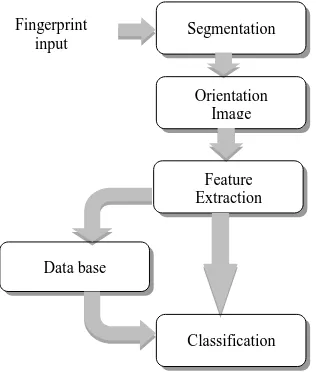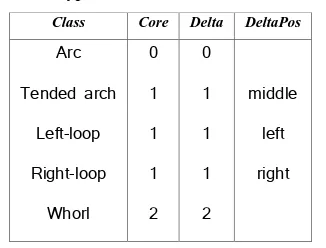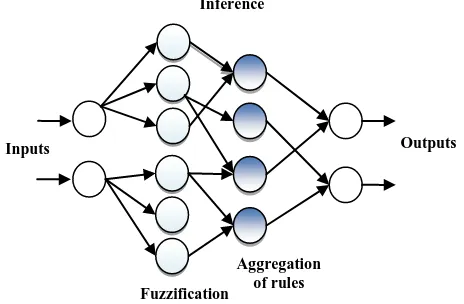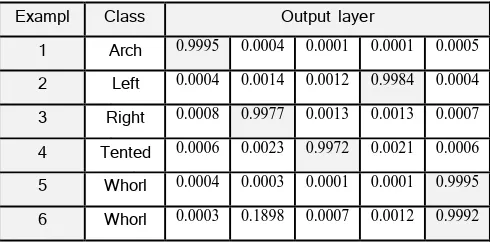Volume 65– No.9, March 2013
Comparison of Neuro-fuzzy Models for Classification
Fingerprint Images
Assas Ouarda
Department ofElectronics. University of BATNA
Algeria
Adjimi Ahlem
Department of ComputerScience.
University of M’sila Algeria
Bouderah Brahim
Department of ComputerScience.
University of M’sila Algeria
Benmahammed Kheir
University Farhat Abbas of SétifAlgeria
ABSTRACT
Classification means to assign a given fingerprint to one of the existing classes already recognized in the literature. A search over all the fingerprints in the database takes a long time, so the goal is to reduce the search time and computational complexity by choosing an appropriate subset of database for search. Classifying a fingerprint images is and will remain a challenging problem in pattern recognition, due to the minimal interclass variability and maximal intraclass variability. This paper presents some intermediate results on fingerprint classification adopting a fuzzy neural network as decision stage. The classification is based on fingerprint feature extraction, which involves encoding the singular points (Core and Delta) together with their relative positions obtained from a fingerprint image. The output vector is defined in terms of membership values to the five classes, arch tented arch, whorl, left Loop and right Loop. Three models of fuzzy neural networks were implemented and fingerprint images from CASIA-FingerprintV5 database were used for training and testing these networks. The experimental results have shown that the performance of Fuzzy neural networks is better as compared to the general neural network for fingerprint classification.
Keywords:
Fingerprint, Classification Approaches, Feature extraction, Singular points, Fuzzy Neural Network.1.
INTRODUCTION
The identification of a person requires a comparison of her fingerprint with all the fingerprints in a database. This database may be very large (e.g., several million fingerprints) in many forensic and civilian applications. In such cases, the identification typically has an unacceptably long response time. The identification process can be speeded up by reducing the number of comparisons that are required to be performed. A common strategy to achieve this is to divide the fingerprint database into a number of subsets. A fingerprint to be identified is then required to be compared only to the fingerprints in a single subset of the database based on its class. The well-known Henry’s Classification scheme divides a fingerprint structure into three major classes or patterns namely Arch, Loop and Whorl. These classes are further divided by researchers into arch, tented arch, left loop, right loop and whorl [1].
Fingerprint classification is a challenging pattern recognition problem that has captured the attention of several researches during the last decades. A number of approaches and various feature extraction strategies for the solution have been proposed, however none of them is considered complete and the problem is still an open question. Maheswari and Chandra presents a detailed review on the existing classification approaches that have applied to fingerprint recognition problems. Various
approaches of fingerprint classification like rule based [2] [3], neural network based [4] [5], genetic algorithm based [6], Support Vector Machines based [4] [5], reveals that neural network based classification provides better results compared to other techniques. Neural Network using back-propagation algorithm gives good results as it learns complex relationship but it consumes a lot of time for training. Mohamed and Nyongesa [7] presented the fingerprint classification system according to the well known Henry system with using linguistic terms and simple fuzzy rules. The method is producing good classification results using fuzzy neural networks
Fuzzy neural networks are born of the combination of neural networks with fuzzy logic in order to reap the benefits of each of these two techniques. The main property of fuzzy neural networks is their ability to be processed in a single tool for both numeric and symbolic knowledge of a system. They thus exploit the learning capabilities of neural networks on the one hand and reasoning capabilities of fuzzy logic on the other. This paper presents an effective method to classify the fingerprint images using a fuzzy-neural network technique. Three types for comparison purposes were adopted; the training set was used to build the different neuro-fuzzy models, namely Pedrycz network, fused compact network and NEFCLASS network. The three models evaluated against the test set and the performance measurements were reported to compare these three different neuro-fuzzy classification approaches. The rest of this paper is organized as follows. Section 2 reports a brief description of classification fingerprint stages. Section 3 presents the fingerprint classification method based on fuzzy-neural network (FNN) approach. Section 4 presents the results of FNN classification after training and testing. Finally section V gives some conclusions from the study.
2.
CLASSIFICATION
FINGERPRINT
STAGES
Fig 1: Fingerprint classification – block diagram
2.1
S
EGMENTATIONThe segmentation step is to remove the blocks belonging to the background of the image depending on their average value. The local mean value ML is calculated and compared with a threshold T:
If ML < T, the block contains no useful information and it is eliminated.
If ML ≥ T, the block contains a part of the fingerprint and is retained.
The threshold T was chosen based on the average value of the overall picture MG such that T=MG/2. All non-noisy block having at least three adjacent blocks as defined noisy is eliminated. The set of blocks at the edge of the image is deleted. An example of segmentation of fingerprint image is shown in Figure 2.
[image:2.595.342.519.233.355.2]
a. Input image b. Image segmented
Fig 2: Effect of segmentation on the fingerprint image
2.2 O
RIENTATION ESTIMATEGiven an image G, the main steps of the algorithm are as follows:
1. Divide G into blocks of size w x w (16 x 16)
2. Compute the gradients∂x(i, j)and ∂y(i, j)at each pixels(i, j) 3. Estimate the local orientation of each block centered at pixels (i, j) using the following equation:
Where θ(i, j) is the orientation angle of the block centered at pixels (i, j) .
The Figure 3 shows an example of the orientation image estimated.
a. Input image b. Orientation image estimated
Fig 3: Result of orientation estimated process
2.3 F
EATURE EXTRACTIONSingular points, namely the Delta and the Core, are manifest as discontinuities in the directional image. They are clearly visible in the fingerprint image in Figure 4. Delta point lies on a ridge at or in front of and nearest to the centre of the divergence of the type lines. A Core point is the approximate centre of the finger impression [7]. To extract singular points global (core and delta) we use one of the simplest and most practical and elegant algorithms: this is the algorithm of Poincaré index proposed by Kawagoe and Tojo [8].
[image:2.595.73.271.455.586.2]Fig 4: The detection result of the singular points by the algorithm of Poincare
A feature encoder is applied for representing the vector of features extracted from fingerprints. This is a list of singular points with accompanying attribute values. The information in includes:
1. Number of deltas, NbDelta; 2. Number of cores, NbCore;
3. Relative Core-Delta position PosDelta.
Feature Extraction
Data base
Classification Orientation
Image Fingerprint
input
[image:2.595.326.524.503.622.2]Volume 65– No.9, March 2013
2.4 C
LASSIFICATIONThis is the last step of a classification system for fingerprints. The latter consists in receiving the extracted features of the fingerprint and taking a decision regarding the class to which the fingerprint belongs.
[image:3.595.326.510.88.197.2]Table 1 illustrate an example of typical feature vectors for different fingerprint classes, namely, Arch, Tended arch, Right-loop, Left-loop and Whorl. Due to noise and errors in segmentation and feature extraction algorithms, it is generally the case that the input feature vectors deviate significantly from the canonical case. For this reason, classifiers that may facewith such deviations are desirable. In this work, it has been proposed to use neuro-fuzzy classifiers.
Table 1. Typical features for different classes
Class Core Delta DeltaPos
Arc
Tended arch
Left-loop
Right-loop
Whorl 0
1
1
1
2 0
1
1
1
2
middle
left
right
3.
C
LASSIFICATIONU
SINGF
UZZYN
EURALN
ETWORKSNeural networks and fuzzy logic are two totally inspired concepts of human reasoning. Although these two numerical models are different in terms of structure, they have many things in common. Indeed, the use of these techniques does not require mathematical model defined as the resolution is based on the numerical values of inputs and outputs for neural networks and logic of the system in the case of fuzzy logic. In addition, the results are generally uncertain. However these techniques can perform additional tasks. Fuzzy logic provides knowledge with a certain degree of uncertainty (or accuracy). On the other hand, neural networks can model and replicate human learning, where the idea of combining these two techniques to create an artificial intelligent system that provides us a resolution of problems as close as that of the human being.
The methods of neural networks can be merged inside the fuzzy systems. This allows them to adapt to new situations and new rules when operating in real time. Similarly, fuzzy logic techniques can be introduced into neural networks in order to develop and improve the expressiveness and flexibility of the network. These combinations are called hybrid systems: neuro-fuzzy systems. Such combinations can not only get closer to the structure of human thinking, but also to obtain a wider range of applications and use the advantages of each technique, namely the simplicity of a fuzzy knowledge, and the learning ability of neural networks. In addition, the use of hybrid networks can reduce learning time by the possibility of introducing a priori knowledge into the decision assisting system. The choice of how to integrate these two techniques is crucial. Different architectures are thus proposed.
The Figure 5 summarizes the principle of neuro-fuzzy system that represents the intersection of fuzzy logic and neural networks.
Fig 5: Principle of neuro-fuzzy system
Input linguistic variables are the components of feature vector of the fingerprint. Their membership functions, are used for fuzzification stages, were presented as in Figure 6.
Fig 6: The membership functions of the input variables of the system.
The fuzzy rules are illustrated below:
R1: If NbCore is small and NbDelta is small Then class is Arc; R2: If NbCore is average and NbDelta is average and PosDelta
is right Then class is Left –loop;
R3: If NbCore is average and NbDelta is average and PosDelta is left Then class is Right –loop;
R4: If NbCore is average and NbDelta is average and PosDelta is middle Then class is Tended arch;
R5: If NbCore is great Then class is Whorl
In this work, three neuro-fuzzy networks were adopted which are Pedrycz network, the fused compact network and NEFClass network for the classification of fingerprint.
3.1
S
TRUCTURE OFP
EDRYCZ NETWORKIt is a neuro-fuzzy network of three layers; it includes a part for fuzzification of inputs followed by a neural network which determines the decisions to take (Fig.7).
The learning of this network involves changing fuzzy relations between synapses of inputs and outputs by acting on the weights of the inputs. The adaptation generally follows the method of back-propagation gradient.
Left Middle Right 1
0
1.5 2 2.5
0.25 0.5 0.75
PosDelta x
Small Average Great
1
0
0.5 1 1.5
0.25 0.5 0.75
NbCore
x
Small Average
n
Great 1
0
0.5 1 1.5
0.25 0.5 0.75
NbDelta
x
Linguistic data
Symbolic data
Rules
Learning parallel operation
Fuzzy logic
Neural network
[image:3.595.91.254.237.361.2] [image:3.595.310.531.272.437.2]Fig 7: Structure of Pedrycz network
3.2
S
TRUCTURE OF FUSED COMPACT NETWORK [image:4.595.62.294.300.452.2]This structure is a neural network of four layers. Each layer corresponds to a step of fuzzy reasoning. The neurons of the first layer corresponds to the inputs of the system, those of the second layer corresponds to the linguistics variables, neurons of the third layer corresponds to the fuzzy rules, while the neurons in the last layer are the outputs of the system (Fig. 8).
Fig 8: Structure of fused compact network
3.3
S
TRUCTURE OFNEFC
LASS NETWORKNEFClass systems (Neuro Fuzzy Classification) are often called three layers fuzzy perceptron networks (Fig.9). Neurons in the input layer represent the inputs characteristics, those of the hidden layer are the inference rules and the neurons of the output layer provide the various classes. In a system NEFClass the connection between the input layer and hidden layer is through fuzzy weights, while the hidden layer and the output layer are connected by Boolean weights.
Fig 9: Structure of NEFClass system
In order to obtain the classifiers, two data sets of feature codes were prepared. The first data set is used for training the networks and the second for testing.
4.
E
XPERIMENTALR
ESULTSResults of the performance of the three neuro-fuzzy networks classifiers were obtained by querying each fuzzy-neural classifier using the test set, and comparing known class labels against the classifier outputs. However we need two sets, one for training and another for testing. The first is to build the classifiers, it comprise 400 fingerprints. The second set is used to test the classifying ability of the proposed models, it contains 200 fingerprints. The data for testing were not applied to train the networks. These two sets are extracted from the standard database CASIA Fingerprint Image Version 5.0 for the five-class problem. These classes are: right loop, left loop, whorl arch, tented arch, and arch. Fingerprints are varied in the five basic classes.
For artificial neural and NEFClass networks, the activation function of the neurons of the layers is the sigmoid function. However, for the two networks fused compact and Pedrycz the activation functions of neurons of fuzzification layers are membership functions and the activation function of neurons of the other layers is the sigmoid function. The learning of the various systems is implemented by the method of back propagation of the error gradient. The learning rate is equal to 0.6 for all systems.
[image:4.595.301.548.430.554.2]To determine the ability of generalization and decision-making, six examples are presented for each network adopted. Tables 2, 3, 4 and 5 present for each example the outputs of the different proposed networks.
Table 2. Output of artificial neural network
Exampl e
Class Output layer
1 Arch 0.985
2
0.011 5
0.000 0
0.014 1
0.011 7
2 Left
loop 0.004
0
0.000 0
0.010 5
0.987 5
0.000 0
3 Right
loop 0.007
5
0.990 2
0.007 7
0.000 9
0.001 4
4 Tente
d arch
0.000 2
0.007 7
0.986 5
0.012 2
0.004 5 5 Whorl 0.004
6
0.004 3
0.003 0
0.000 0
0.991 2 6 Whorl 0.034
8
0.998 6
0.002 6
0.000 0
[image:4.595.299.550.593.714.2]0.001 8
Table 3. Output of fused compact network
Exampl e
Class Output layer
1 Arch 0.9992 0.0001 0.0002 0.0000 0.0008
2 Left
loop
0.0008 0.0009 0.0015 0.9976 0.0016
3 Right
loop
0.0006 0.9975 0.0017 0.0009 0.0014
4 Tented
arch
0.0026 0.0021 0.9962 0.0031 0.0007
5 Whorl 0.0005 0.0005 0.0000 0.0005 0.9994
6 Whorl 0.0000 0.0245 0.0001 0.0016 0.9994 Fuzzy weights Boolean weights
Booleans
Input layer
Rules layer
Outputs Inputs
Output layer
Inputs Outputs
Inference
floue
Aggregation of rules Fuzzification
Inputs
Fuzzification of network
Volume 65– No.9, March 2013
Table 4. Output of NEFClass system
Exampl e
Class Output layer
1 Arch 0.9992 0.0001 0.0002 0.0000 0.0008
2 Left
loop
0.0007 0.0000 0.0012 0.9990 0.0000
3 Right
loop
0.0001 0.9970 0.0027 0.0001 0.0005
4 Tented
arch
0.0003 0.0043 0.9954 0.0015 0.0000
5 Whorl 0.0007 0.0003 0.0000 0.0000 0.9993
[image:5.595.49.294.249.370.2]6 Whorl 0.0000 0.0257 0.0000 0.0000 1.0000
Table 5. Output of Pedrycz network
Exampl e
Class Output layer
1 Arch 0.9995 0.0004 0.0001 0.0001 0.0005
2 Left
loop
0.0004 0.0014 0.0012 0.9984 0.0004
3 Right
loop
0.0008 0.9977 0.0013 0.0013 0.0007
4 Tented
arch
0.0006 0.0023 0.9972 0.0021 0.0006
5 Whorl 0.0004 0.0003 0.0001 0.0001 0.9995
6 Whorl 0.0003 0.1898 0.0007 0.0012 0.9992
For the examples 1, 3, 4 and 5 the decisions taken by the systems used are all valid, but the output of Pedrycz network is closest to the output binary code.
For the example 2, the output of NEFClass network is closest to the binary code of the class left loop.
Decisions taken by the fuzzy neural networks: NEFClass, Pedrycz and fused compact for the sixth example are corrects and the best decision is taken by the NEFClass network. While the artificial neural network presents a case of indecision. The following table 6 presents the classification rates of the different networks used.
Table 6. Classification rate for the proposed networks
Network ANN Fused compact Pedrycz NEFClass
Classification rate 96% 100% 100% 100%
The approaches based on artificial neural networks and those based on fuzzy neural networks provide very good classification rate and can be used for fingerprint classification and performance of neuro-fuzzy networks exceeds of artificial neural networks. This is due to the fact that the architectures of these systems have not been chosen arbitrarily but to model the fuzzy
reasoning. So, the more the network is assisted, more generalization ability improves. In addition, the Pedrycz network is the best in decision making than the other two neuro-fuzzy systems.
5.
C
ONCUSIONIn this work, fuzzy-neural networks have been developed for fingerprints classification problem. Fingerprint classification provides an important mechanism for automatic fingerprint recognition systems. Three neuro-fuzzy networks have been constructed and used as classifiers. Each one classifies input fingerprints into five categories according to the number of the core and delta (singular points), and their relative positions. The classifiers were tested on 200 images of the CASIA-FingerprintV5 database. For the five-class problem, classification accuracy as high of 100% is achievable. The use of neuro-fuzzy approach for the classification increases the credibility of the output of the classification system.
6.
R
EFERENCES[1] S.U. Maheswari, E. Chandra, “A Review Study on
Fingerprint Classification Algorithm used for Fingerprint Identification and Recognition,” International Journal of Computer Science And Technology IJCST Vol. 3, Iss ue 1, Jan. - March 2012
[2] K. Karu, A.K. Jain, ,"Fingerprint Classification, Proceedings of Pattern Recognition", Vol. 29, No. 3, pp.389-404, 1996.
[3] F.A. Afsar, M. Azir, M. Hussain, ,"Fingerprint Identification and Verification System using Minutiae Matching", National Conference on Emerging Technologies, pp. 141-146, 2004.
[4] S. Shesha and P. S. Sastry, “Fingerprint Classification Using a Feedback-Based Line Detector," IEEE Transactions on Systems, Man, and Cybernetics, Part B: Cybernetics, vol. 34, no. 1, pp. 85- 94, 2004.
[5] C. Park, H. Park,"Fingerprint classification using fast Fourier transform and nonlinear discriminant analysis", Pattern Recognition, Vol. 38, No. 4, pp. 495-503, 2008.
[6] X. Tan, B. Bhanu, Y. Lin, ,"Learning Features for Fingerprint Classification", AVBPA 2003, LNCS- 2688, pp. 318-326, 2003.
[7] S. M. Mohamed, H. Nyongesa, ,"Automatic Fingerprint Classification System using Fuzzy Neural techniques", IEEE International Conference on Artificial Neural Networks, Vol. 1, pp. 358-362, 2002.
[8] M. Kawagoe and A.Toko, “Fingerprint Pattern



